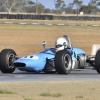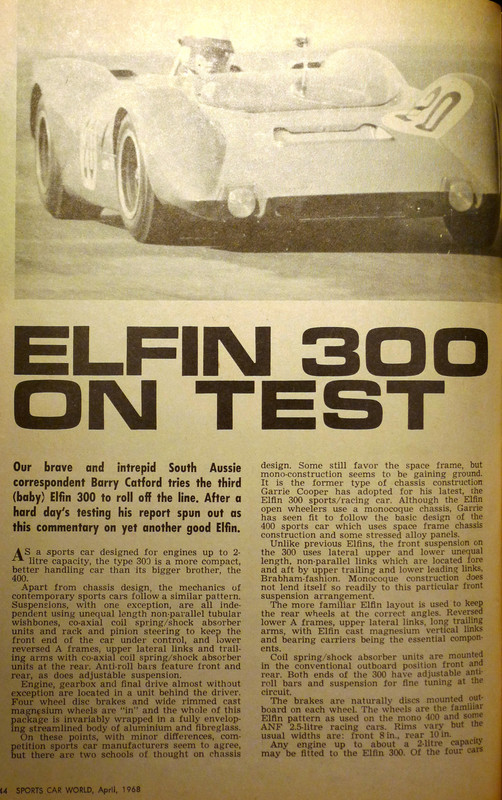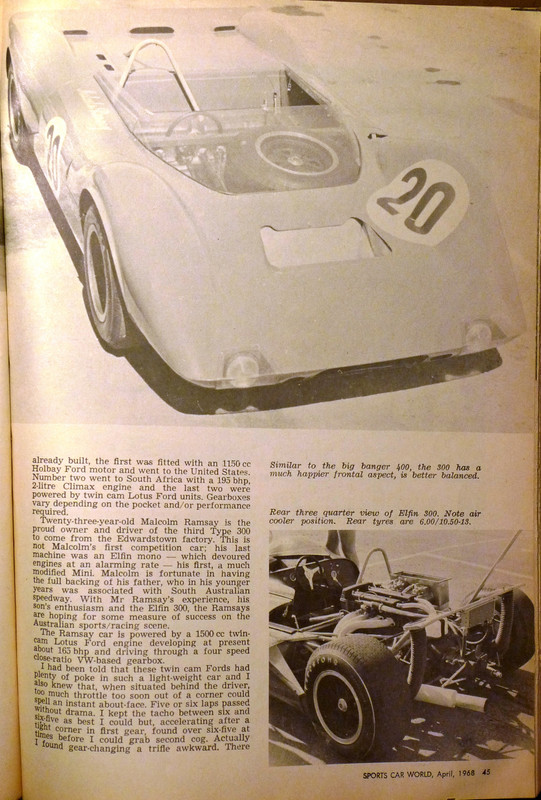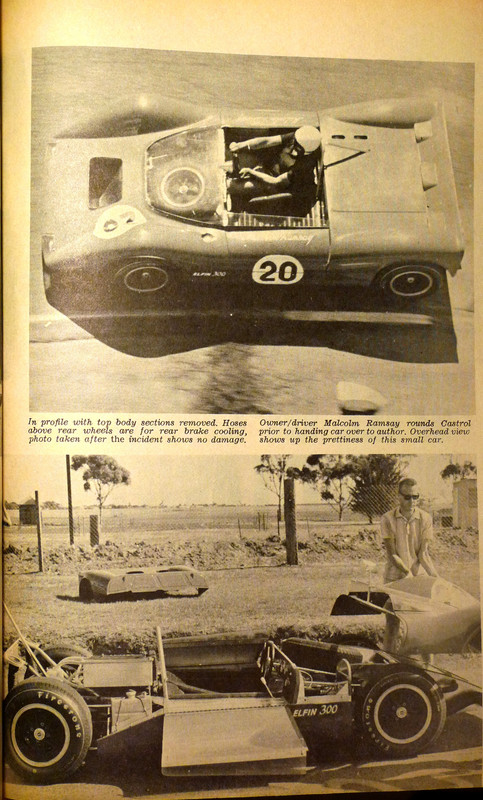
Elfin 300 tyres
#1

Posted 25 January 2008 - 13:53
Rims are 7.5inch and 10inch, so 1150x13 with diameter of 578mm is the only choice for the rear.
BUT the problem comes with the front; 450x13 is 560mm diameter, anything wider has a greater Ø than the rear (500/588mm, 550/606mm).
Is the difference between F&R too great with a 450/1150 combination?
Advertisement
#2

Posted 25 January 2008 - 17:28
It would seem to me that you are getting close to putting this loveliest of little sports racers back on the track... that's great news.
#3

Posted 25 January 2008 - 17:40
#4

Posted 26 January 2008 - 17:28
However the only tyre that fits a 10 inch rim is the 1150, an inch wider than original but the consensus so far seems that 5:8 is OK.
Ray, the car is probably a bit further away from completion than you think but at least the chassis, brakes, gearbox, and engine are done - the latter with softer cam for longevity. The wheels have been tested and re-chromated,a screen mould made up, and the body has been sorted by a real craftsman - he actually phone me up to tell me that all the compound curves had been hand beaten, not rolled.
It really is a very nicely made car (almost entirely original too) but whenever I find a part stamped '65 it makes me sad that it was not shipped until '67. Pre-66 would have been a kinder class.
:
#5

Posted 26 January 2008 - 19:50
Garrie Cooper built the first of his 400s in late 1965, with two or three more emerging by the end of '66. This was his first post-Mallala sports car, the 300 had to come after it. The Elfin 600, which shares many components and attributes, didn't hit until 1968. But some of those parts had been used on updates of the Elfin Mono openwheelers in earlier times. I guess rear uprights would be the obvious parts that might carry 1965 dates.
I'm sure that 1965 would be a kinder class for you, as it would be for owners here, but if I were you I would simply rejoice in the fact that you have one of the best looking and most effective little sports racing cars ever built.
There was only a small number of them, yours is the least used of them all and possibly the most original, a real benchmark. And there's another factor that will save you money as you race it... it doesn't have that nightmare twin-cam Lotus head on the engine!
Additionally, the engine and gearbox are better matched than those with the twin-cams, which at times find the Mk 5 and Mk 6 Hewlands marginal.
I think you have plenty to be grateful for there, Graham. A truly lovely little car with a proven ability to be extraordinarily quick for its day, it's already got the wheel widths it needs for the kind of power you can get out of that engine and doesn't need to be bastardised to fit bigger wheels.
In some ways I think you have Garrie Cooper's very best car there. Bring it to Australia some time and I guarantee people will drool over it. Your problem anywhere else in the world, of course, is that nobody will know what it is, you'll be forever fielding "What is it? Where was it made?" questions.
#6

Posted 27 January 2008 - 12:55
I agree about the car, and I certainly look forward to trying it out. Anything original that can be retained will be, including the wheels, and at least Cooper was savvy enough to put Elfin badges on the bonnet, wheels, and steering wheel to promote the brand - it should help a little in UK paddocks. Maybe Mr Walkinshaw might help with some sponsorship - it could provide very useful advertising!
#7

Posted 27 January 2008 - 13:31
Firstl, there was a very successful series being run at Calder each year which gave them great strength. Second, there were not many cars in the 2.5-litre class for which the Gold Star and Tasman Cup were run. This meant that a handy operator in a useful 1.5 car could get a run in the big races, even pick up some minor placings.
Cooper himself was a solid competitor in these cars, while he didn't drive a sports car until the seventies that I can recall.
It is, however, altogether possible that he laid down the beginnings of a car in 1966 after getting the first couple of 400s out the door and then put it aside to keep development work going on the Mk 2 Mono and other customer cars.
#8

Posted 27 January 2008 - 18:32
#9

Posted 27 January 2008 - 21:22
Until July (or August, probably), Cooper had no firm plans to build a V8 sports car. Then Matich crashed and approached him.
It could well be that plans were advancing on building a Lotus 23-beater (the 300) when Matich came along and Cooper saw greater urgency in getting that design and build done. Once delayed, it could well have continued to sit 'on the shelf' until a later date.
#10

Posted 28 January 2008 - 08:04
It seems that the design concept of the 300 was initially developed by Garrie sometime in 1965 as a potential replacement for the Elfin Mallala and in response to an order from Carl Haas for a small sports car suitable for G modified events in the US. Although Haas acquired an engine and transmission for the car Garrie was diverted to other projects as Ray Bell has suggested and the first 300 (No. 67-4) was not completed until 1967 as confirmed by the chassis number assigned to it and a notation in the infamous exercise book in which Garrie recorded details of each car constructed at Conmurra Ave.
A dispute then arose between Haas and the partnership of Donald Mansell and Chuck Krueger over who had the rights to Elfin representation in the US. Part of the resolution of that dispute involved transfer of Haas' order for the 300 to Mansell and Krueger and sale of the engine and transmission to them. The car was completed in July 1967 and was tested at Mallala prior to shipment to New York where it is said to have arrived in September 1967.
As Ray says these are delightful cars and its a great pity that more were not made. I would certainly love to have one as a stablemate for my 600. I think an appropriately engined Elfin 300 and a 600 would make as good a combination as you could get of a small sports racing car and a competitive single seater from the late 60's. That was very well demonstrated in events down under during that period.
#11

Posted 28 January 2008 - 11:56
It does make more sense for the 300 to have been a project in 1965 rather than 1967... the Lotus 23s were achieving great success in terms of outright placings at that time and the future, popularity and potential of the V8 cars was well and truly just speculation at that time.
If it had gone to production in 1965, and Matich hadn't crashed the 19B, I would think that quite a number more would have been built before V8 cars overshadowed the little cars to the extent that they began to do.
Even the fairly modest changes between the 300 and the 350 altered the charm and unadulterated prettiness of the 300. The 360s were nothing when it came to good looks... just effective cars.
It's that combination of really smart good looks, competitiveness and simplicity that appeals to me with the 300. And while you might be happy to have a twin-cam in your stable, I think I'd be just as happy with smaller-engined versions like Graham has.
#12

Posted 28 January 2008 - 12:13
Go to Chris Meadans site www.Motorsportarchive.com.au
Look in the "Racing Car Profiles Section"...
This is the link to the exact Page:
http://members.tripo.....00 Climax.htm
Follow the prompts to get to Bruce Tyson photos...... Rebuilding of the Elfin 300 and the restoring of the
Climax engine...
#13

Posted 28 January 2008 - 12:32
Does anyone know?
#14

Posted 28 January 2008 - 14:13
Ray, I read your Fast Past article on the 300, a very nice piece with some terrific pictures - where did you get them? I really could do with a photo of the rear view mirror mounting post as it (and much of the screen) was missing.
#15

Posted 28 January 2008 - 19:42
Otherwise, Motor Racing Australia has a very extensive range of photos of cars racing back through that era.
Please e.mail me that pic, Graham. And if you go through the pics in the Elfin Sports Cars threads, see if anything there shows your mirror mount.
#16

Posted 29 January 2008 - 05:50

I can possibly rescan that part of the slide for better detail, although some of the mirror is reflected in the windscreen, if that makes sense.
#17

Posted 29 January 2008 - 06:56
Maybe some of the other pics you have, and higher res scans?
#18

Posted 29 January 2008 - 07:28
My line of thought was that if a more detailed shot of that item would help, I'd hunt out the original 35mm slide and rescan that area of the slide for more detail.
Unfortunately I dont have any dash shots of the 300.
I do have a shot of the dash bracket of the Niel Allen 400 showing the original centre mirror mount.
Edit:
I have had a quick look at some of my 400 shots, and the centre mirror bracket appears to support the windscreen as well. In the 300 one that I posted, the same seems to apply.
My previous post #12 on this thread may also help
#19

Posted 29 January 2008 - 13:08
Advertisement
#20

Posted 30 January 2008 - 10:27
I do know the mount comprised a tubular rod with intermediate screen support, but the diameter, frame support detail, and dash bracket are not known. I could guess most of it but a period pic would be great.
Latest tyre thoughts are 175/550/13 and 475/1150/13, still smaller diameter at the front but closer tread widths and construction.
Ray, is Motor Racing in Australia a book or magazine?
#21

Posted 30 January 2008 - 10:39
#22

Posted 30 January 2008 - 11:53
I think that the tyre sizes you suggest are all much smaller in height than the car would originally have had. You are certainly now on the right track with the the idea of using the same construction type at both ends and I think you will need to stick with the dual sized Dunlops as I doubt that the L or M series CR 65s which the 300 probably originally used will now be available in appropriate sizes.
However, I would suggest that you would be better to use 4.75/10.00 x 13 at the front and 6.00/12.00 x 13 at the rear. That is what the 600 was using in 1968 and I beleive that both sizes are still available as, until I changed to Avons a few years ago, that was what I was still using on my 600. I would suggest that, while the 300 probably had something else in 1967 (e.g. L or M series Dunlop CR65s), it too would have had those tyres in '68 when the range of dual sized Dunlops first appeared.
Your 7.5" and 10" wheels are narrower than the 600 which, in 1968 and 1969, had 8.5" and 12" wheels but the tyres I have suggested remain within the recommended rim width ranges for those sizes and I have seen them used quite successfully on the narrower rims. Both the tyre heights and the front rear relationship would then be much more reflective of how the car ran in the 60's.
#23

Posted 30 January 2008 - 13:05
With the little 1150 engine, I'd reckon tyres intended for and ideal on something with the addition power your 600 has might be a bit on the big side.
Of course, there is always the tyre height problem. That era created a lot of suspension headaches as tyres got lower in profile...
#24

Posted 30 January 2008 - 20:32
The tread widths are 7.1" for the 4.75/10.00 and 9.4" for the 6.00/12.00 and I agree that the smaller engined car may be somewhat overtyred with these sizes. However, I don't think you would now be able to get anything with the correct height in a narrower width and, from an appearance perspective, the tyre height will be more important than the width particularly in a sports car where the tyre width is not so visible. The sizes Graham had suggested are far lower than I think the 300 originally ran particularly at the rear and would make it hard to maintain ride height and the correct suspension geometry. Its all a compromise these days as many of the original tyre sizes are simply not now available.
#25

Posted 31 January 2008 - 01:48
The geometry compromise has got to be an important issue.
In the picture Graham has sent me (thanks for that... it's lovely!) the Mono alongside the 300 seems to be on Dunlops, but in that era there was also some Firestone and Goodyear stuff available. I remember the Mildren cars were on Goodyears in that period, even their F2 car... but I guess Goodyear don't make the retro stuff either?
Bearing in mind that 8s and 10s were the regular wear of the 1300cc F2s, 7.1" and 9.4" can't be too bad.
#26

Posted 31 January 2008 - 16:28
HP Tyres kindly offered to send me some dead tyres to try for size before I make a choice but they said that the choice was really between the preferred historic F2 set-up of 175/550 (7" tread) and 475/1150 (8.3" tread) or the Chevron B8 set up that uses much wider (and taller) rears. He reckoned the biggest problem would be getting any heat into the larger tyres to work safely.
The original tyres were marked 5L13 and 6L13, with tread widths roughly as per number - how simple life was in those days.
#27

Posted 01 February 2008 - 05:29
I would certainly take up HP's offer of a trial fitment of some dead tyres as most of the sizes mentioned will be wider than the original and you may have issues of body clearance to address as well as the ground clearance and suspension geometry concerns. I would suggest that you should be very careful about the advice handed out by modern tyre suppliers as few have real experience of cars from this period in their original specification and many of them have no understanding of how much higher in profile the tyres from the 1960's were.
The availability compromise forces many current historic racers to use tyres much lower in profile than the cars originally had but I always prefer to keep the height as close as possible to original. It's a big appearance factor and it does simplify the geometry issues without need to resort to moving suspension pickup points as many people seem to do these days without regard to the requirement for originality. You will almost inevitably end up with something wider than would be ideal but I would not worry too much about tyre temperatures - just use a bit more right foot and remember that any of these current tyres are way softer in compound than the originals and come up to temerature much quicker!!
It would make sense that the original 1967 tyres were 5.00L x 13 and 6.00L x 13 and the tread widths for those sizes listed in my 1969 Dunlop catalogue were 4.8" and 6.1" respectively which is pretty much as you have measured them. Unfortunately those sizes were not listed in the most recent catalogue I have seen and I assume that they are no longer available. The overall diameters listed for them in 1969 were 23" and 25" and, whatever you use, should, in my opinion, be as close as possible to those heights.
The 4.75/10.00 x 13 is 22.7" in diameter and the 6.00/12.00 x 13 is 25" which is about as close as you will ever get. The sizes suggested to you by HP tyres are only 21.9" and 22.8" in diameter which is far too low particularly at the rear.
#28

Posted 01 February 2008 - 08:40
#29

Posted 01 February 2008 - 20:28
I just hope you're ready to field all the questions you're going to get from people who've never seen such a beautiful little thing.
It strikes me, by the way, that all that Paul has said in his last post is correct. The ride height issue, with suspension still using original pickups, demands you get the diameter right before you worry about width. We always reckoned in the Clubmans that the wheels being covered helped them gain temperature compared to similar openwheelers too. And the comment about current tyres being softer is very relevant.
Just post some pics of it leading a bunch of 23s and Elvas, won't you?
#30

Posted 02 February 2008 - 20:18
#31

Posted 02 February 2008 - 20:44
Get yourself a fibreglass copy of the body and drive with gay abandon. You should easily beat any sub-1500cc 23s.
#32

Posted 05 July 2010 - 12:33
Graham,
I would certainly take up HP's offer of a trial fitment of some dead tyres as most of the sizes mentioned will be wider than the original and you may have issues of body clearance to address as well as the ground clearance and suspension geometry concerns. I would suggest that you should be very careful about the advice handed out by modern tyre suppliers as few have real experience of cars from this period in their original specification and many of them have no understanding of how much higher in profile the tyres from the 1960's were.
The availability compromise forces many current historic racers to use tyres much lower in profile than the cars originally had but I always prefer to keep the height as close as possible to original. It's a big appearance factor and it does simplify the geometry issues without need to resort to moving suspension pickup points as many people seem to do these days without regard to the requirement for originality. You will almost inevitably end up with something wider than would be ideal but I would not worry too much about tyre temperatures - just use a bit more right foot and remember that any of these current tyres are way softer in compound than the originals and come up to temerature much quicker!!
It would make sense that the original 1967 tyres were 5.00L x 13 and 6.00L x 13 and the tread widths for those sizes listed in my 1969 Dunlop catalogue were 4.8" and 6.1" respectively which is pretty much as you have measured them. Unfortunately those sizes were not listed in the most recent catalogue I have seen and I assume that they are no longer available. The overall diameters listed for them in 1969 were 23" and 25" and, whatever you use, should, in my opinion, be as close as possible to those heights.
The 4.75/10.00 x 13 is 22.7" in diameter and the 6.00/12.00 x 13 is 25" which is about as close as you will ever get. The sizes suggested to you by HP tyres are only 21.9" and 22.8" in diameter which is far too low particularly at the rear.
I reckon you're right about original tyre sizes - here's Kevin Bartlett knocking the shine off them!


Edited by SJ Lambert, 16 September 2012 - 04:10.
#33

Posted 05 July 2010 - 23:50
Reading this reminds me of a discussion I had with Garrie about tyre sizes. And he said basically what Paul said about diameters being quite important to suspension geometry and that wide low profile tyres were a backward step for older cars that were not designed for them.The discussion inspired me to put bigger diameter [more original] diameter rubber onto my Holden Sports Sedan which was an improvement.
I can also remember an article once in a magazine about Ray Winter in the Yellow Sub about the rear suspension geometry and the then gun tyres on that car.
So tyre diameter is more important than width. Then it is trying to find a tyre that goes under the car without clearance issues
#34

Posted 07 July 2010 - 09:31
That is a very pretty little motorcar!.
Reading this reminds me of a discussion I had with Garrie about tyre sizes. And he said basically what Paul said about diameters being quite important to suspension geometry and that wide low profile tyres were a backward step for older cars that were not designed for them.The discussion inspired me to put bigger diameter [more original] diameter rubber onto my Holden Sports Sedan which was an improvement.
I can also remember an article once in a magazine about Ray Winter in the Yellow Sub about the rear suspension geometry and the then gun tyres on that car.
So tyre diameter is more important than width. Then it is trying to find a tyre that goes under the car without clearance issues
Here it is at Cumberland in 1968 at it's debut meeting. Driver Chuck Krueger

Edited by SJ Lambert, 29 March 2011 - 19:34.
#39

Posted 03 October 2010 - 09:11

I've seen a couple of shots of this, the second 300 with the 2.0 litre Climax FPF engine, being unloaded onto South African soil in the sixties. I don't suppose anyone has race reports or shots of it when in the hands of Tony Jeffries or Garth McGilliwie?
In reference to an earlier post, the rear bodywork does differ slightly from original spec, as was made without reference to original mould.
Edited by SJ Lambert, 29 March 2011 - 19:31.
#41

Posted 13 September 2012 - 04:51
#43

Posted 15 September 2012 - 15:32
I would think there was a suggestion at the time, or Garrie was hoping for an opening, that Mildrens would return to the Sports Racing class. They'd left it after the demise of the Mildren Maserati, while they had run a 23 before that.
#49

Posted 24 June 2014 - 05:41
Here are some pics of the ex Ramsey car in Mike Bruce's hands - Tassy 1969



#50

Posted 24 October 2014 - 05:02
From the same batch of April 68 Sandown slides added to the Elfin Mono thread this week.
Here David Robertson patiently waits for his race. Also in this shot is Ian Cook, sitting in the Bob Jane Elfin 400 and the rear wheel visible is the Lotus 15 of Bevan Gibson. The 400 being the car Bevan would drive at Bathurst 12 months later and unfortunately be killed in.
Thank you to James Lambert for having a tinker with the original scan, making it more viewer friendly.
Stephen
Edited by cooper997, 29 April 2018 - 08:32.



























